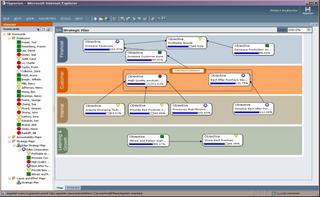So the cat is finally out of the bag and I can talk about it publicly.
Hyperion System 9 is finally here! System 9 is the industry's first Business Performance Management System. What does that mean?
Well, business performance management, or corporate performance management as it is defined by Gartner, "includes the processes used to manage corporate performance (such as strategy formulation, budgeting and forecasting); the methodologies that drive some of the processes (such as the balanced scorecard or value-based management); and the metrics used to measure performance against strategic and operational performance goals." (Gartner Research, "Corporate Performance Management Applications Explained, October 4, 2005).
How is this different from Business Intelligence? Business Intelligence, as envisioned by Howard Dresner, who coined the phrase, probably would not be much different from Business Performance Management if it evolved along the route that he expected it would. However, what Business Intelligence has wound up becoming is the manifestation of reporting taken to its logical extreme. State of the art pure-play Business Intelligence tools allow end-users to format and layout reports in any way imaginable. They also allow for data exploration using the established techniques pioneered by OLAP vendors.
However, a report in and of itself is hardly valuable without a notion of the process with which it is attached to. And a process in and of itself is hardly valuable without an understanding of the goals of the organization. And the goals of an organization remain ephemeral if they are not operationalized in the form of strategic, operational, and tactical plans. So Business Performance Management software attempts to provide a closed-loop, management decision-making infrastructure that builds upon Business Intelligence technologies but applies it as part of a structured management methodology, such as that formalized by the discipline of Management Accounting.
How does System 9 meet the Business Performance Management mandate? We'll dive into the details in an upcoming set of posts. In the meanwhile, there is a ton of new information on
http://www.hyperion.com/.





